To commemorate the 40th anniversary of its first flight, Bill Ramsey gives us a personal look at his all-time favourite aircraft – the Hawk.
To my eternal shame it took a phone call from Gareth Stringer to remind me that 21 August this year is the fortieth anniversary of the Hawker Siddeley / BAE Systems Hawk’s first flight (Editor’s note – that aircraft, XX154 is still flying, with QinetiQ / ETPS at Boscombe Down). Lets be up-front, despite my affection for my current aircraft and many others I’ve been lucky enough to fly, the Hawk is my all-time favourite by a considerable margin.
Its time in service, and of course it’s still going strong, broadly matches my own and our paths have crossed a few times down the years. So, rather than just give you a dry history of Hawk I thought I’d share a few of my own memories of it. It is worth mentioning that back in the day, instructors who had previously flown the Gnat and Hunter referred to it as “The Shiny P*sspot” – so it had some prejudice to overcome!

Life begins at 40! © Gareth Stringer – www.globalaviationresource.com
However it would be wrong not to trumpet a little of this incredible little jet’s global success. Around about a 1000 of them have been made in different marks with the majority exported around the world – from Finland to South Africa and Australia to the USA (the T-45 Goshawk of the US Navy – an astonishing defence export success). This record undoubtedly makes it one of the UK’s greatest exports of the last 40 years. It’s a truly multi-role aircraft – advanced trainer, lead-in fighter trainer, operational support aircraft and lightweight fighter, to name but a few.
Domestically it has trained countless RN and RAF fast jet pilots (and navigators) and a bit more unusually has been used by the Centre for Aviation Medicine to help sufferers overcome chronic airsickness problems. However, it is probably most well-known to the general public as the Red Arrows’ aircraft. Together they have flown more than 4,500 displays in excess of 50 countries. Quite a record, but more of that later.

Bahrain – just one of the export successes © Karl Drage – www.globalaviationresource.com
So, when did we first meet? My log book says Monday 4 February 1980 when I was doing what was called a Fast Jet Familiarisation Course at RAF Valley. Up to that point I had flown the Vulcan and Jet Provost, but in those days the RAF could afford to let Qualified Flying Instructors, or QFIs, experience something they hadn’t done so before (I later did the same thing on the F-4 Phantom and Harrier). Interestingly my pilot that day was Flight Lieutenant Jeff Glover who was unlucky enough to later achieve fame during the Falklands campaign when he was shot down in a Harrier GR3 and taken prisoner by the Argentinians.
I flew the Hawk six times that week which confirmed my already burning ambition to become a fast-jet pilot myself. The fact I was able to fly six times, in what was four days, is a pointer to one of Hawk’s key strengths – it is an incredibly reliable and serviceable machine.

An earlier schemed T1 © Kevin Wills – www.globalaviationresource.com
Luckily enough, the RAF finally became fed up with my constant nagging and December 1981 found me back at RAF Valley at the start of that “cross-over” process. I see in my log book that I must have been specially chosen as my first two flights were with the Station Commander! As an indicator of the steep learning curve to come, the first trip was general handling and the second took us straight into formation flying! I must have done okay as, on 18 December 1981, I found myself flying the Hawk solo for the first-time.
Those who have done it will agree this is a moment of pure joy – a first chance to appreciate the Hawk, in particular its wonderful handling characteristics and relatively quiet cockpit, without the incessant drone of an instructor to interrupt the enjoyment (no offence QFIs, I have been that irritating drone myself!).

100 Squadron RAF © Chris Wood – www.globalaviationresource.com
As that particularly bad winter moved into February 1982, I reported to RAF Brawdy in Pembrokeshire to start Tactical Weapons Training on the Hawk. This one was camouflaged and sported an Aden cannon pod below the fuselage and practice bomb carriers under the wings. This was definitely a step in the right direction! The beautiful Hawk was slightly less user-friendly in this fit but nonetheless still a delight to fly. For the next four months it showed me its more operational edge as I learnt the basics of air-to-air and air-to-ground weaponry, air combat and low level attack formation flying.
It was referred to in the then-contemporary TV programme ‘Fighter Pilot’ as “The Sport of Kings” which pretty much nails it – although that persistent drone in the back seat was often still there! The Hawk and I parted company at that point, and I went off and flew the Tornado for much of the next decade.

Royal Navy Hawk T1 © Karl Drage – www.globalaviationresource.com
But July 1993 found me back at the Central Flying School (CFS), this time as the senior RAF Examiner for the Hawk – a friendship happily renewed. CFS Exam Wing is responsible to Commandant CFS for the maintenance of pure flying standards and flying instruction across the three Services and foreign air forces, by invitation. So, for instance, I led teams to Jordan and Sri Lanka during this time but that’s another story. In May 1996 I led a CFS Team to Oman to carry out a Standards visit to RAFO. This was to the island of Masirah where the new Hawk 103 was based – the first of the modern, glass-cockpit Hawks (as was the Hawk 200 – a single seat variant which has enjoyed far less success than the two seater).
After some discussion it was agreed that I would fly the Hawk 103 from the front seat – the first non RAFO pilot to be allowed to do so. Before doing so I had to undergo training on a synthetic training aid which simulated the machine’s navigation and attack systems (luckily for me, very similar in operation and presentation to Tornado) called a Part Task Trainer. These are common enough these days but then it was a step into the future for the Hawk. My first flight was with the Squadron Commander during which it became apparent that I was the one being tested, not the other way round, as is usually traditional on these visits!

Hawk 209, departing Warton on delivery to the Indonesian Air Force © Derek Bower
The 103 was a bigger, more powerful aircraft than the sporty T Mk 1. But with its modern avionics and more front-line aircraft feel, I thought it an excellent trainer. Really, all the way from there to the current Mk 2/128 and related export versions has been a process of steady Hawk evolution. A month later I had my first exposure to a Red Arrows overseas deployment when I flew Hawk XX294 with the team to Jakarta. Not all in a day like an airliner, but 12 flights flown over some pretty inhospitable places, in seven days. Not for the first, or indeed last, time I really began to love the reliability of this wonderful jet. All too soon though my CFS time ended and more ground tours loomed………
Time rolls past and I’m sitting in my office in Riyadh pondering a visit to the Royal Saudi Air Force Headquarters when the phone rings. The caller wonders if I would be interested in becoming the next Wing Commander Red Arrows? Tricky one, eh?

Red Arrows © Gareth Stringer – www.globalaviationresource.com
So in March 2001 I’m back at Valley getting re-acquainted with my old friend and then it’s off to RAF Scampton. There’s not enough space on GAR to cover all the adventures that me and the Hawk had over the next four years, but whether it was upside down at 100 feet with Synchro or at 45,000 feet crossing the Atlantic, the Hawk just went on showing what a thoroughbred it is. Favourite bits? Photochasing was a new skill for me so that was good. I did this often, chasing the Team during display practices at Akrotiri, and once whilst in formation with Concorde and once across Niagara Falls.
Chasing the F-117 was a spotter’s paradise, while flying back-seat with Red 8 during a display at the Great Pyramids was also a high-spot. Incidentally, the back seat of the Hawk is worth a mention as its about the only aircraft I know of where the instructor has a better view than the student in the front seat. This is a massive plus point for a training aircraft.

Included for the wow factor, and the photo-ship was Bill’s Red Arrows’ Hawk! © E.J.van Koningsveld
So, apart from utter reliability (and I should praise the engine manufacturer Rolls-Royce whilst I write this) what is so good about the Hawk T1? Its handling, particularly in roll, is light and precise, making aerobatics a joy, especially at low-level. This also makes it an easy aircraft to fly in close formation. For the student, its definitely a fast jet, but without any of the vices of most front-line types down the years, so a good place to learn your trade and grow confidence.
It goes a long way on very little fuel and if the engine does stop (very occasionally it has done) it glides forever – well about two miles per 1000 feet of height loss. So on a transit at 43,000 feet you can look for a diversion airfield up to 86 miles away!

The sun isn’t setting on the Hawk just yet © Karl Drage – www.globalaviationresource.com
Well, that was me and the Hawk, hope you can at least begin to see why I think its such a great jet.
If you consider that whilst the modern Hawks are utterly different on the inside to the original, on the outside they look pretty much identical, it just shows how right Hawker Siddeley got it all those years ago.
Bill Ramsey
Huge thanks to Bill and, to commemorate the Hawk’s 40th further, we’ve put together a number of galleries, celebrating the aircraft in service across the decades, and across the world.
We hope you enjoy them, and if you’ve got any Hawk memories, or questions for Bill, please leave a comment below.
Royal Air Force Hawk T1
Royal Navy Hawk T1
Red Arrows
US Navy T45 Goshawk
Royal Air Force Hawk T2
Export and development Hawks


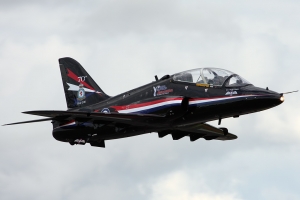


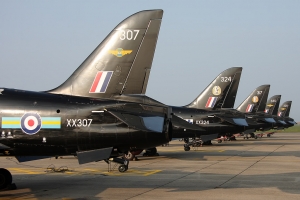













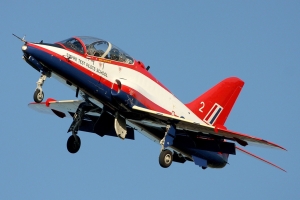
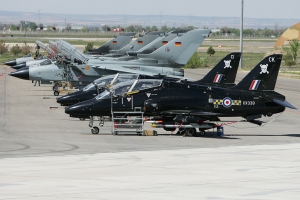


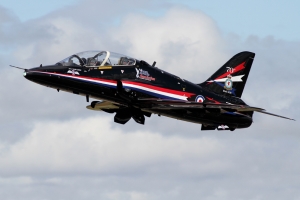










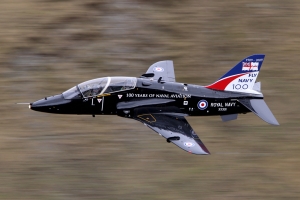













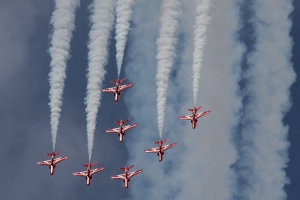
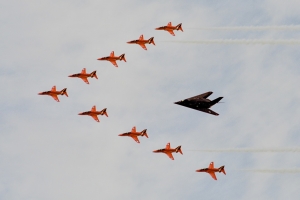














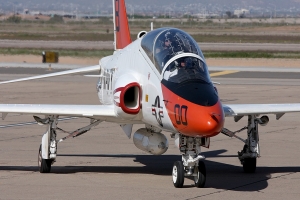





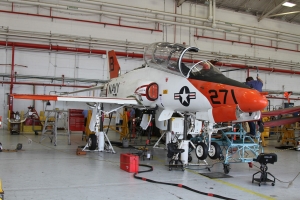











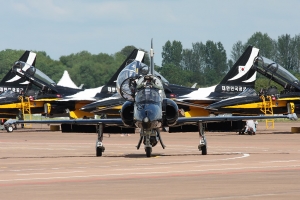







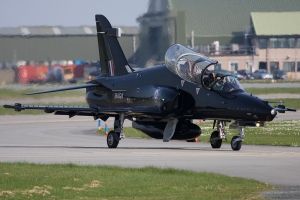




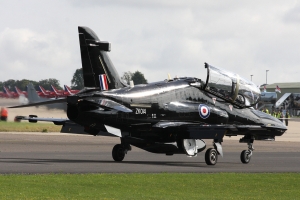














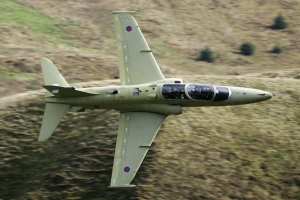








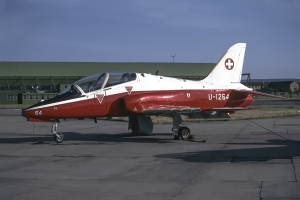




Oh, to see the Hawks again, moved down to North Devon early in 1994 just in time to see them all depart from RAF Chivenor to RAF Valley, in the time we had we saw a Black Hawk for the first time, Chivenor had the RAF Hawk Demo Pilot, who obviously did so well that he also flew a F-117A with the USAF, regret cannot remember his name.
Great article and selection of Hawk Pictures, thanks
Mike